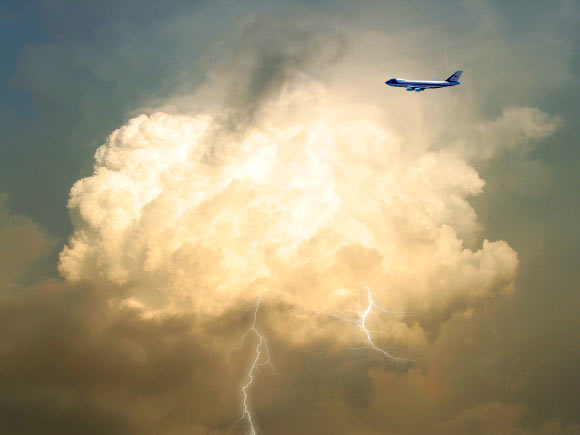By analyzing several years of weather radar observations in Finland, a research team led by University of Helsinki scientists has discovered that planes landing in or departing from an airport could locally increase precipitation rate by 6-14 times. The observations show that falling ice crystals from upper clouds could seed lower clouds and therefore increase rain or snowfall intensity through the process called snowflake aggregation; during this process bigger faster falling particles are formed by ice particles colliding and sticking together.
“The interesting thing about this feature is that it is caused by aircraft, but it is not caused by pollution,” said study lead author Dr. Dimitri Moisseev, a researcher at the University of Helsinki and the Finnish Meteorological Institute.
“Even if there would be absolutely ecological airplanes, which don’t have any combustion, no fuel or anything, it would still happen.”
Both water droplets and ice crystals form clouds. Pure water can stay liquid down to minus 40 degrees Fahrenheit (minus 40 degrees Celsius) without dust particles or other suitable surfaces present to seed crystallization into ice. So water droplets that condense into clouds can be much colder than the typical freezing point of 32 degrees Fahrenheit (0 degrees Celsius). Such supercooled liquid clouds are common in low- to mid-level cloud layers.
Air pressure changes from passing aircraft can trigger these supercooled water droplets to freeze into ice crystals. Air expands abruptly in the wake of wing and propeller tips, causing a dramatic local drop in pressure and temperature.
Inside a cloud of water droplets that is already supercooled between 5 and minus 4 degrees Fahrenheit (minus 15 and minus 20 degrees Celsius), the passing aircraft can drop the temperature below minus 40 degrees Fahrenheit and instigate the formation of ice crystals.
The new ice crystals help freeze more supercool water droplets, setting off a chain reaction of crystal formation in a widening circle around the path of the aircraft.
When the crystals fall, they create holes or streaks of clear air in the cloud, sometimes opening a window of blue sky if the cloud layer is thin. In most cases, the ice crystals evaporate before they reach the ground.
Meteorologists have known that passing aircraft can freeze water droplets into ice crystals and previous work had suggested that the process could enhance rain and snow in underlying clouds, but the effect had not been captured in detail.
In the new study, Dr. Moisseev and his co-authors from the Finnish Meteorological Institute, Vaisala Oyj, the Universities of Reading and Helsinki reviewed 11 years of dual-polarization weather radar observations in the Helsinki region and found 17 days with repeat cases of the characteristic linear streamers between December 2008 and January 2018.
The researchers examined flightpaths near the Helsinki-Vantaa airport to see whether the streamers could be caused by passing aircraft.
Flightpaths archived to 2011 confirmed aircraft passed within 1-6 miles (2-10 km) of the intense precipitation streamers in most of the cases observed.
“The intensified precipitation basically follows the track of an airplane above the cloud,” Dr. Moisseev said.
“It could extend over hundreds of miles, but the cross-section would be maybe 328 feet (100 m). So it’s a very narrow, long feature.”
The additional ice crystals raise the rate at which crystals collide to form larger snowflakes, intensifying snowfall.
This could happen if an airplane flies directly through a precipitating cloud, but the scientists suspect something more complicated is going on, because their data locates the starting height of rain and snow enhancement far above the layer that is already precipitating.
“The airplane-generated ice crystals most likely fall from a supercooled upper cloud layer into a lower layer that is actively raining or snowing, begetting more rain or snow from the lower cloud layer,” they said.
The study is published in the Journal of Geophysical Research: Atmospheres.
_____
Dmitri Moisseev et al. Inadvertent localized intensification of precipitation by aircraft. Journal of Geophysical Research: Atmospheres, published online January 12, 2019; doi: 10.1029/2018JD029449








